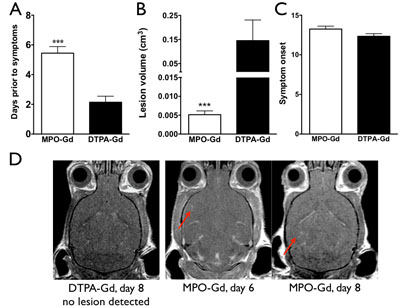


New Imaging Agent for Early Lesion Detection and Treatment Tracking in MS
Posted January 19, 2012
John Chen, M.D., Ph.D., Massachusetts General Hospital, Boston, Massachusetts
Multiple sclerosis (MS), a debilitating autoimmune disease of the central nervous system, presents with a variety of symptoms that resemble those of other nervous system disorders. In many cases, imaging is used to assist with detection of the disease. However, since both symptoms and conventional imaging are nonspecific and do not always correspond to each other; it is very difficult to perform early diagnosis and treatment.
Found in active inflammatory MS lesions, myeloperoxidase (MPO), which is a highly oxidizing enzyme abundantly secreted by inflammatory cells such as active neutrophils, macrophages/ microglial cells, can be very harmful to the brain. MPO activity is highly associated with demyelination, a process during which myelin sheath is lost from the regions surrounding axons. Dr. Chen's laboratory has recently shown that a novel magnetic resonance imaging (MRI) agent called, MPO-Gadolinium (Gd), is highly specific and sensitive for detection of MPO activity. Moreover, MPO-Gd is very stable, nontoxic, and well tolerated by animals even at high doses. Furthermore, administration of an MPO-specific inhibitor significantly ameliorated symptoms and reduced relapses.
Dr. Chen received a Metric Development and Validation Award through the Fiscal Year 2009 Multiple Sclerosis Research Program to test two hypotheses: (1) metrics derived from MPO-Gd imaging to measure the status of inflammation and dememylelination in early subclinical MS, and (2) by noninvasively tracking and quantifying MPO activity in the development and treatment of active demyelinating lesions, MPO-Gd imaging to establish as a method to assess the effectiveness of therapy.
Dr. Chen used the experimental allergic encephalomyelitis (EAE) mouse model of MS to evaluate MPO-Gd imaging systematically over the course of the disease to determine whether MPO-Gd can detect and confirm preclinical and subclinical disease activity even when the animals do not exhibit any symptoms. Using serial imaging, Dr. Chen's research team showed that MPO-Gd imaging is superior to conventional MR contrast imaging with DTPA-Gd for the detection of asymptomatic disease activity in the brain, at both acute and chronic relapsing stage. Specifically, MPO-Gd imaging detected subtle disease activity 5 days prior to symptom onset, while conventional MRI agents were only able to detect disease activity in the brain 2 days prior to symptom onset Moreover, MPO-Gd imaging detected lesions that were 30 times smaller than those detected using conventional agents.Early preclinical detection of active inflammatory lesions with MPO activity by MPO-Gd imaging in comparison with DTPA-Gd imaging Additionally, Dr. Chen treated MS animals with three different therapeutic regimens, including interferon beta, glatiramer acetate, and a specific MPO inhibitor 4-aminobenzoic acid hydrazide (ABAH) followed by MPO-Gd imaging. All three treatments showed reduction in MPO activity and lesion burden and demonstrated that MPO-Gd imaging can be used as an imaging biomarker to track and quantify changes following treatment. Interestingly, treatment with the MPO inhibitor was more effective in reducing disease activity, suggesting that MPO itself may play a role in the development of the EAE pathology. These imaging findings were correlated with clinical scores, biochemical assays, and inflammatory changes. For example, following treatment with ABAH, flow cytometric analyses demonstrated there was a 20% to 40% decrease in inflammatory cells recruited to the brain. Moreover, demyelination was significantly reduced. Furthermore, MPO inhibition reduced the severity of EAE at all stages as well as the mortality associated with it. Overall, Dr. Chen's results demonstrated that MPO-Gd imaging is a highly sensitive imaging biomarker for early detection of preclinical and subclinical disease activity and the tracking of treatment effects in EAE mouse model. Moreover, the identification of MPO as an important player in the EAE pathology laid the groundwork for novel MS treatments targeting MPO.
Link:















